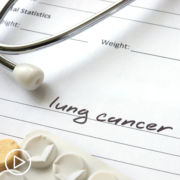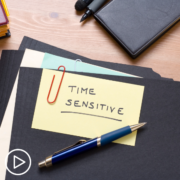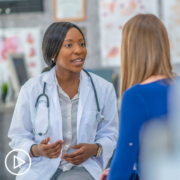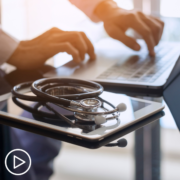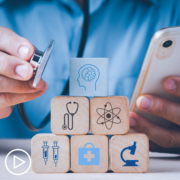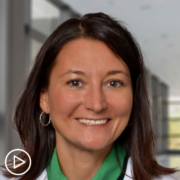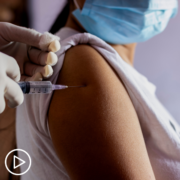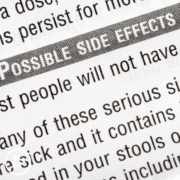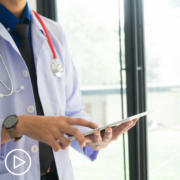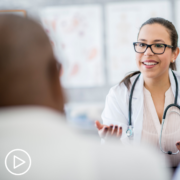What Should Patients Know About DLBCL Treatment and Research? from Patient Empowerment Network on Vimeo.
Why should diffuse large B-cell lymphoma (DLBCL) patients feel empowered to participate in their treatment and care decisions? Dr. Kami Maddocks reviews current DLBCL therapies, discusses developing research in the field, and shares advice encouraging patients to speak up and become active members of their team.
Dr. Kami Maddocks is a hematologist who specializes in treating patients with B-cell malignancies at the The Ohio State University Comprehensive Cancer Center – The James. Learn more about Dr. Maddocks, here.
Download Guide
See More From The Pro-Active DLBCL Patient Toolkit
Related Programs:
Transcript:
Katherine:
Hello and welcome. I’m Katherine Banwell, your host for today’s program. Today we are going to talk about diffuse large B-cell lymphoma, known as DLBCL and how you can feel empowered to speak up and be a partner in your care. Before we get into the discussion, please remember that this program is not a substitute for seeking medical advice.
Please refer to your health care team about what might be best for you. Well, joining us today is Dr. Kami Maddocks. Dr. Maddocks, welcome. Would you please introduce yourself?
Dr. Maddocks:
Thank you. I’m Kami Maddocks. I’m a lymphoma doctor at the Ohio State University James Comprehensive Cancer Program.
Katherine:
Excellent. Thank you so much for being with us today.
Dr. Maddocks:
Thank you for having me.
Katherine:
Well, since the goal of this webinar is to help our viewers feel empowered in their care, in your opinion, what does it mean to be an empowered patient?
Dr. Maddocks:
I think an empowered patient is invested in their health and in their medical care. This can look like different things for different patients but I think being educated about their disease, being invested in decision making, along with their providers, and then being invested in the outcomes of their treatment and their disease.
Katherine:
What do you feel is the patient’s role in their care?
Dr. Maddocks:
I think it’s important that the patient partners with their care providers and their family, while they’re going through treatment for any condition. So, I think the most important thing is that the patient is comfortable with their care. And I think that includes being educated on their disease process. For some patients, this is going to be doing some of their own research, for some patients, this is going to be really relying and trusting in what their physician and care provider say, and for some patients, this is going to include other information that they seek out after they get the information from their care provider.
Katherine:
How do you empower patients?
Dr. Maddocks:
When I first meet a patient, I schedule a large block of time to spend with the patient, and I like to explain to the patient their new diagnosis. Or, if it’s not a new diagnosis, what I know about their disease, try to understand if they understand what I’m explaining, and what they know before coming to see me.
If there are treatment options, discuss those and go over those and make sure that I ask them to repeat or go over what they understand, from what I’ve explained from that. And then, making sure that they’re comfortable with available options outside of that. So, are there clinical trials available? Should they be seeking second opinions? Where is it best for them to get those second opinions? And then, ensuring that we have open lines of communications, so they have ways to contact me or my office. Making sure that they’re comfortable following up with questions that come in throughout the disease treatment and process. Ensuring that they know to contact us if there are changes or concerns so that we can address things in real time.
Katherine:
Yeah. That’s great advice, Dr. Maddocks. Thank you. Now, let’s learn more about DLBCL. For those who may be newly diagnosed, what is it?
Dr. Maddocks:
Diffuse large B-cell lymphoma is a type of non-Hodgkin’s lymphoma. So, this is considered a blood cancer. Lymphomas are a cancer of the lymphocyte, which is one of the types of blood cells that form your immune system. So, when you think about your nodes, these are part of the cells that help fight different types of infection. So, diffuse large B-cell lymphoma is one of the types of non-Hodgkin’s lymphomas, it’s aggressive, and it is considered an aggressive form of lymphoma. And it’s when you get a cancer of those lymph cells that often involved the lymph nodes but could also involve bone marrow, blood cells, other sites outside of the lymph nodes.
Katherine:
Do we know what causes DLBCL?
Dr. Maddocks:
For the most part, we don’t know what causes diffuse large B-cell lymphoma. So, most of the time, it’s going to arise with patients not having risk factors. We know that age is the most common risk factor with the median diagnosis of a patient in their 60s.
Although, we also know that diffuse large B-cell lymphoma, why it’s more common to be diagnosed later in life, can occur across all the age spectrum. So, you see this in pediatric adolescents, young adults, and older adults. There are some causes. These represent more than minority of cases but certain viruses, including HIV virus, can be associated with the development of lymphoma. Certain other medical conditions, like rheumatologic conditions and some of the treatments for these, can be associated, and then, some chemical exposures. But in general, most of the time, we’re not going to have an identified cause.
Katherine:
What are the symptoms?
Dr. Maddocks:
They can look a little bit different for different patients. So, because this is often a cancer, most of the time there will be lymph node involvement. For some patients, they can actually feel or somebody will see a lymph node that grows. Most of the time, when this occurs, it’s going to be in the neck, under the armpits, or in the groin area.
Patients can start to have symptoms from other sites, of those lymph nodes growing or disease so that they can get pain or shortness of breath. Or they can have what’s called B symptoms. So, B symptoms are inflammatory like symptoms from the lymphoma, and these include weight loss. So, a rapid change in weight for no reason. Night sweats. So, daily night sweats, we call them drenching night sweats. They wake up the patient, they soak their clothes, sometimes they soak the whole bed. And then, fatigue. So, extreme fatigue, not able to do your daily activities. And then, occasional people will have cyclical fevers.
Katherine:
Are there different types of DLBCL?
Dr. Maddocks:
So, in general, diffuse large B-cell lymphoma, there’s one major subtype. You can divide it into different pathological or molecular subtypes.
So, where the cell develops lymphoma during the cell’s development, there are different chromosome abnormalities. So, there are different categorizations but in general, diffuse large B-cell lymphoma itself is considered – it’s treated, often, the same even with these different subtypes. So, there are different subtypes but in general, they’re all considered a form of diffuse large B-cell lymphoma.
Katherine:
They’re under this umbrella of DLBCL.
Dr. Maddocks:
Yeah. Yeah.
Katherine:
Yeah. Do patients usually get diagnosed after they experience some symptoms?
Dr. Maddocks:
So, because this is an aggressive lymphoma, there are a lot of patients that will have symptoms with this, and that’s how they’ll present. Via either noticing the lymph nodes, having the B symptoms, or having pain, or other abnormalities from the lymphoma progressing.
Occasionally, whereas indolent lymphoma is more commonly found of incidentally. Occasionally, that’ll be the case with these, but I would say a fair number of patients have some sort of symptom or something that brings them to medical attention.
Katherine:
How does DLBCL progress?
Dr. Maddocks:
So, they’re different, as far as there’s more aggressive and less aggressive. So, some patients can develop symptoms, really, over days to weeks. Whereas, some patients are more weeks to months.
Katherine:
“Okay. Let’s turn to treatment options. Is a person with DLBCL treated right away?”
Dr. Maddocks:
They’re treated pretty quickly after the diagnosis. So, typically, when somebody has a diagnosis, they undergo a number of different tests, including lab work, imaging work, sometimes for their biopsies.
So, that information is gathered over days to sometimes a few weeks process. Then, when you have all that information, you go over the results, go over the treatment at that time. So, it’s typically treated not within, usually, a day of diagnosis but it’s not something that you spend weeks or months before treating.
Katherine:
Yeah. What are the different types of treatments available?
Dr. Maddocks:
So, the diffuse large B-cell lymphoma is treated with chemotherapy and immunotherapy. So, a combination of an immune antibody therapy and chemotherapy. There is a role in some cases for radiation, but never just radiation alone and never just surgery alone. So, there’s always what we call a systemic treatment. So, a treatment that goes everywhere. Because this is considered a blood cancer, it’s a cancer of those cells, it can really spread anywhere.
And so, just cutting it out with surgery or just radiating the area doesn’t treat everything, even if you can’t identify it.
Katherine:
Can you get specific about some of the treatment classes?
Dr. Maddocks:
Yeah. So, the most common treatment for diffuse large B-cell lymphoma is a chemo immunotherapy called R-CHOP. So, this is three chemotherapies and antibody therapy that’s direct called rituximab (Rituxan) that’s directed at a protein on the lymphoma cells. And then, a steroid called prednisone, given with the chemo and then for a few days after. There was a study that recently showed an improvement with switching one of those drugs with another immunotherapy that’s an antibody conjugated to a chemo drug. But that’s not yet been approved. There are clinical trials available. So, looking at these treatments that might be new or combining therapies with this standard treatment.
And then, very occasionally, there are certain features of diffuse large B-cell lymphoma. There are particular few different subtypes that are classified a little bit differently, that are treated within an infusional therapy called Dose Adjusted R-EPOCH.
Katherine:
What about stem cell therapy? Is that used?
Dr. Maddocks:
Stem cell therapy is used in the relapse setting. So, if a patient doesn’t go into a remission or if they relapse after achieving a remission with their chemotherapy, then stem cell transplant is an option. So, there are actually two different types of stem cell transplant. One from yourself and one from somebody else. In lymphoma, we typically do one from yourself, where you donate your own cell before. But we don’t use that as part of the initial treatment.
Katherine:
So, if somebody is high risk, Dr. Maddocks, is the approach different for them?
Dr. Maddocks:
So, it depends. We define high risk in different ways. So, there’s a specific type of lymphoma called double hit lymphoma, where there’s a few chromosomal translocations associated with the lymphoma, that we give a little more aggressive chemo immunotherapy regimen. There are also other subtypes, including a rare type of lymphoma called primary mediastinal B-cell lymphoma. Again, categorized a little bit different but sometimes included as a large cell lymphoma. We also give that treatment for.
Katherine:
Is a cure possible?
Dr. Maddocks:
Yes. A cure is possible. When you look at patients who are treated with initial chemotherapy, we cure somewhere between 60 percent to 70 percent of patients with the initial chemotherapy. If patients’ relapse, depending on their age and their condition, they’re candidates for other therapies.
And therapy including other chemo and stem cell transplant is potentially curable in some patients. And then, there’s a newer therapy called chimeric antigen receptor T-cell, or CAR T-cell therapy, which also looks like it’s curing a subset of patients who relapse or don’t respond to initial therapy.
Katherine:
Okay. What are the side effects that patients can expect with these treatments?
Dr. Maddocks:
So, when they get the treatment, on the day they get it, there can be an infusion reaction to the rituximab or antibody therapies. So, the first treatment, that treatment is given very slowly and titrated up. If patients have a reaction, we stop it, treat the reaction, and then they’re able to continue therapy but again, that first day, it can take several hours for that one antibody to get in. And then, later, therapies are given at a more rapid pace.
So, about 70 percent of people who react, it can be really almost anything. Some people get flushing, some people will get a fever, some people have shortness of breath or their heart rate will go up.
Katherine:
Okay. All right. Any other side effects?
Dr. Maddocks:
Yeah. So then chemotherapy is meant to kill cells during the cell cycle. So, cancer cells divide more rapidly, chemotherapy is targeting them, but it also effects good cells in the body, specifically those that divide at a more rapid pace. The biggest risk of chemotherapy is infection.
So, it effects the good white blood cells that fight infections. It can affect your red cells that carry your iron, gives you your energy. Or your platelets which help you to clot or not bleed when you get caught. So, infection is the biggest risk of chemotherapy. So, usually, with this regimen, that infectious risk is highest within the second week of treatment, that treatment is given every three weeks.
So, we tell patients they should buy a thermometer, check their temperature, they have to notify their doctor or go to the ER if they have a fever. Besides infection, there’s a small percentage of patients who might need a transfusion. GI toxicity. So, nausea, vomiting, diarrhea, mouth sores, constipation, all of which we have good treatments for. So, we give medication before chemo to try to prevent people from getting sick and then give them medicine to go home with, if they have any nausea. We can alter those medications as time goes on, if they’re having any problems. So, we just need to know about it. Most patients will lose their hair with this regimen.
It can affect people’s tastes, it can make their skin more sensitive to the sun, and then, less common but potential side effects are it can cause damage to the nerves. Or something we call neuropathy, which most often patients will start with getting numbness or tingling in their fingers and toes, and we can dose adjust if that’s causing some problems.
And then, there’s a risk to the heart with one of the drugs. So, the heart should pump like this. The heart pump function can go down. So, we always check a patient’s heart pump function before they get their chemo, to make sure that they’re not at higher risk for that to happen.
Katherine:
So, all of these approaches are used in initial treatment?
Dr. Maddocks:
Mm-hmm.
Katherine:
Okay. So, how do you know if a treatment is working?
Dr. Maddocks:
So, as far as evaluating treatment, you get a scan before you start treatments, so we know where all the lymphoma is at. And then, typically, you get some sort of scan in the middle of treatment, and then after, you complete your six cycles of treatment. Or for early stages, sometimes patients will get less than six cycles. So, we get scans to make sure it’s working. So, you can tell by those things, how much has gone, hopefully all of it has gone by the end. Occasionally, patients that had a lot of symptoms to start with, their symptoms will go away, and then they’ll start coming back.
This is less common, because the majority of patients do respond to chemotherapy. It’s less common to get patients who are what is called refractory, meaning they don’t get any response to therapy. So, occasionally they’ll note symptoms but a lot of times, we’ll see something on that mid-therapy or end of therapy scan, if it’s not going to make it all go away.
Katherine:
Yeah. So, if a treatment doesn’t work, what happens then?
Dr. Maddocks:
If treatment doesn’t work, it depends a little bit – and now it depends a little bit on the timing of that treatment not working. So, it used to be that patients who were eligible for treatment, no matter if it didn’t work right away or if it put them into what we call a remission, so there’s no evidence of disease and then it relapsed, they would have the option of further chemotherapy and then an autologous stem cell transplant. So, a bone marrow transplant where they donate their own cells.
If they were in a good enough health or if they were not – to do that, you have to donate your own bone marrow cells and as we age, we make less bone marrow cells. So, once you reach a certain age, your body can’t produce enough cells to donate to a transplant. In those patients, we offer them less aggressive chemo options, which were not known to be curable but could put them into remission again, for a while. More recently, there has been some that chimeric antigen receptor T-cell therapy that I mentioned where you actually donate your own T cells. So that’s –And your lymphoma is of your B cells.
Your T cells are in another immune cell that should recognize that lymphoma is bad and attack it, and they’re not functioning properly. So, you donate your own T cells and they’re sent off and reengineered to target a protein on the tumor. Then, you get those cells back and they’re meant to target the lymphoma and kill the lymphoma cells.
So, that is now an approved therapy for patients who don’t achieve the remission – so, who’s first chemo doesn’t work or if they relapse within a year of completing chemo. So, that’s a possibility. The chemo and transplants a possibility. Or there’s other approved therapies now, that can be given as second options or third or later options, which have been shown to keep patients in remission for a while.
Katherine:
Dr. Maddocks, you touched up on this a moment ago but what are the approaches if a patient relapses? What do you do?
Dr. Maddocks:
So, you would rework them up if they relapsed. Similar to that, if they relapse within a year and they have access to the CAR-T and they’re healthy for that, then that’ll be an option. The second type of chemotherapy in the transplant. So, you can’t just go straight to a transplant. You have to get a different type of chemotherapy to try to get the disease under control again, before you would go to a transplant.
Or there’s a number of other targeted therapies that are approved. So, there’s other – I talked about rituximab is given in the first line, that targets a CD-20 protein, there’s an antibody that targets a CD-19 protein that’s given out in relapse. There’s another antibody drug – there’s actually two antibody drug conjugates. So, an antibody that targets the protein on the cells that are attached to a chemo, that’s given. Or there’s different chemotherapy and then even some oral therapies.
Katherine:
Okay. So, there’s a lot of different options available for people.
Dr. Maddocks:
Correct. And there’s always clinical trials. So, there’s always the option to find something where we’re studying some of these newer therapies. They’re therapies in combination.
Katherine:
Well, that leads us right into emerging options and I’d like to talk about that. Have there been any recent developments in how DLBCL is treated?
Dr. Maddocks:
There had been recent developments. So, the CAR T-cell therapy, there is now three approved options for patients. And so, even patients who maybe are older and not considered candidates for a stem cell transplant because of other medical factors, might be able to get the CAR T-cell therapy. This is now, again, approved in the second line. There are a couple antibody drug conjugates, polatuzumab (Polivy) and loncastuximab (Lonca, Zylonta), they target proteins called CD-79 and CD-19.
And the polatuzumab’s the one that probably is going to be available for part of the front-line treatment in the future. There’s the antibody tafasitamab (Monjuvi) and lenalidomide (Revlimid). These are all approved therapies in the relapse setting. There are also therapies that are being studied and showing promising activity, which we think are probably likely to be approved in the future. There’s something particularly called bi-specific antibodies.
So, this targets a protein on the tumor cell but also a protein on the T cell. So, remember I said the T cells aren’t functioning. So, this targets the protein on the lymphoma cell but then targets a protein on the T cell to engage it to attack the lymphoma cell.
Katherine:
Right. Combination approaches?
Dr. Maddocks:
Yeah. So, there are a number of combination approaches under study a lot of the therapies that I mentioned, like the bi-specific antibodies, the antibody drug conjugates. These are all therapies that – they have side effects – I hate to say they’re well-tolerated – they have side effects but their side effects are such that they can be combined with other agents, that have different toxicities that are combined with each other. And so, there’s a lot of ongoing trials looking at combining these. There’re also oral targeted therapies that target proteins that are known to help the lymphoma cells survive and these are modulator therapies, BTK inhibitors, other inhibitors, that are being evaluated and used in combinations.
Katherine:
Thanks, Dr. Maddocks. That’s really helpful information. So, now that we understand more about DLBCL and how it’s treated, let’s talk about self-advocacy and how patients can engage in their own care. Why is it so important for patients to have a voice in their decisions?
Dr. Maddocks:
Well, I always tell my patients that they are the person most invested in their selves and their outcomes. As a care team, we certainly are invested in them and we want them to do well but they’re the one that knows their body, they know what’s going on, they’re the one that has to, essentially, live with all these outcomes. So, they have to be invested in what’s going on, they have to be invested in making sure that they know their care team is informed of things because we only see them in different periods of time and we’re not with them all the time to know what’s going on.
Katherine:
Right. It’s not always easy for patients to speak up. So, I’d like to debunk some common misconceptions that patients have, that may be holding them back. First one is, “I’m bothering my doctor with all my questions.” Is that true?
Dr. Maddocks:
That is not true at all. So, the best thing is an informed patient. So, I want to answer all their questions. “What is the disease or diagnosis?” “What are the treatment options?” “What do we know now?” “What are we learning?” I need to know what’s going on. I always tell my patients that I can’t help them with what I don’t know. So, if somebody shows up, they get once cycle of treatment and they show up for a second cycle and they’ve had all these problems and never called or notified me, first of all, we weren’t able to help them. There’s a lot of things we can do to help them and if we don’t know what’s going on, we can’t help.
And second, that might impact that second treatment, whereas knowing and knowing that sooner, we can plan to make changes.
Katherine:
Yeah. That’s really good advice. Here’s another one. “My doctor’s feelings will get hurt if I get a second opinion.”
Dr. Maddocks:
Not at all. So, I always encourage patients that they should get a second opinion, third opinion, whatever they need. Number one, I think it’s important that a patient feels comfortable with their diagnosis and their treatment
plan because I really think that things go better if they understand that and they’re comfortable. If they’re always doubting what’s going on, it’s really hard to develop that trusting relationship. And I think it’s very important that a patient has a trusting relationship with their care team.
I think most of the time, when you get a second opinion, you’re probably going to hear or get the same advice. And so, that helps a patient to feel comfortable. Sometimes, there may be clinical trials out there that your doctor didn’t know about, that are options, and a doctor’s always going to be happy if there’s something out there available, that might make the patient outcome better, that they didn’t know about.
And lastly, I would say there are a lot of doctors who treat all types of cancer and there are some doctors that specialize in certain types of cancer. And so, if you were seeing a doctor who treats multiple different kinds, but want to see a doctor who specializes in a particular kind, they may be aware of a recent trial or a recent development that your doctor doesn’t know. Not because there’s anything wrong with that doctor, it’s just that there is so much data to keep up with these days, in cancer, that a specialist might be able to provide a point of view that somebody else doesn’t know.
Katherine:
Yeah. Another question or comment is, “There isn’t anything that could be done about my symptoms or treatment side effects. So, why should I even say anything?”
Dr. Maddocks:
That’s a great question but the thing is, a lot of times there are things. So, the one thing is, some of the treatments we use for some of our cancers, including lymphoma, have been around for a really long time. But some of the things that have changed, are our supportive care or our ability to treat patient side effects. So, I think that it’s always important that patients let us know if they’re having side effects because maybe nausea – so, we give medication to prevent that.
Usually, I send patients home with two different types of nausea medication. But if that’s not helping, I have more than two in my toolbox, I just don’t know to prescribe them if the typical things aren’t helping. So, a lot of times, there are things that we can do. Sometimes you have to tweak the dosing of the chemo, but really, the only way you can help with symptom management is if you know somebody’s having symptoms.
Katherine:
Right. So, when somebody starts to have side effects from the treatment, should they contact their care team right away?
Dr. Maddocks:
Yes. They should contact their care team right away. There are certain side effects, like having a fever during chemo, where they really need to go to the emergency room to be evaluated, to make sure it’s nothing. Because an infection can be very serious when you’re getting chemotherapy. Other side effects that are less emergent but, yes. Most of the time there’s a patient number that patients can call, where they can seek, like a nurse help line, where they can seek assistance, and that call can be escalated depending on the symptoms and what needs to be helped.
But I think, again, it’s important that we know what’s going on so we can help patients. And then, if something needs to be further investigated – because occasionally there will be something that’ll make us think, “Oh, we really need to evaluate this patient because what if it’s more than what it seems?”
Katherine:
Right. Are there any other misconceptions that you hear about from patients?
Dr. Maddocks:
I think, just in general, thinking about the patient taking care of themselves. So, a lot of times there can be resources that patients have questions on. Things like exercise. Things like nutrition. Things in the environment that they can be exposed to. Just different things. I think it’s always important that you ask your care team if there’s any question because they’re going to best be able to tell you versus just assuming something.
There’s a lot of good information that patients can get from educational sites. There’s a lot of good information on the internet but there’s also a lot of bad information, or inaccurate information on the internet. So, I think it’s great for patients to use resources and educate themselves but I think that it’s always good to confirm with your care team. Myths versus facts.
Katherine:
Yeah. Yeah. That’s really important. Do you recommend that patients continue getting vaccines? For COVID, for flu?
Dr. Maddocks:
Yes. So, particularly, when you look at lymphomas, this is a cancer of the immune system. The cancer can make your immune system compromise the treatment. While you’re getting treated makes your immune system compromised. And even for a period after treatment, your immune system can be compromised. So, it’s important to protect yourselves against infection. Sometimes the efficacy of vaccines in the middle of treatment might not be as good as not being on treatment.
But that said, there’s no data that the vaccines are harmful. You do have to be careful about live vaccines when you’re under treatment, and you should ask your doctor about not the typical vaccines, of course. But I think that it’s very important to take every step that patients can, to try to prevent themselves from battling something in addition to them already undergoing treatments, their body’s already going through a lot.
And so, anything that we can do or they can do to help prevent them from dealing with more than they already are, I think is important.
Katherine:
To close, what would you like to leave the audience with? Do you think that people can feel hopeful about the tools available to treat DLBCL?
Dr. Maddocks:
Yeah. I think, if you look at the progress we’ve made in the last five years, the last drug approved was rituximab in the early 2000s, and now in the last five years, we have had numerous therapies approved. Now it looks like we’re changing front-line therapy and numerous therapies that relapse. So, there’s a lot of – these are all promising therapies, some of them potentially curing patients that we weren’t able to cure before.
And so, they’re more available to patients. There’s a lot of promising drugs in clinical trials. And so, I think it’s hard to deal with a diagnosis but there are options for patients, both initially and at relapse, and I think seeking out what’s available, both to you and in clinical trials, is important to helping further improve outcomes.
Katherine:
Yeah. Dr. Maddocks, thank you so much for taking the time to join us today.
Dr. Maddocks:
Thank you so much. It’s been a pleasure.
Katherine:
And thank you to all of our collaborators. To learn more about DLBCL and to access tools to help you become a more proactive patient, visit powerfulpatients.org. I’m Katherine Banwell. Thanks for being with us today.
